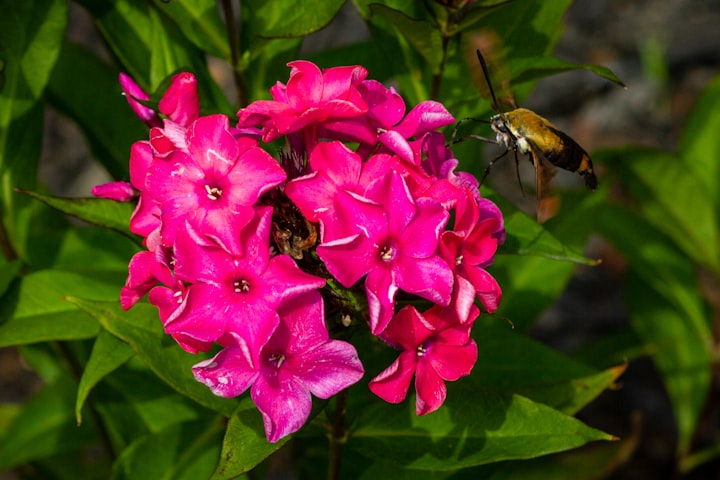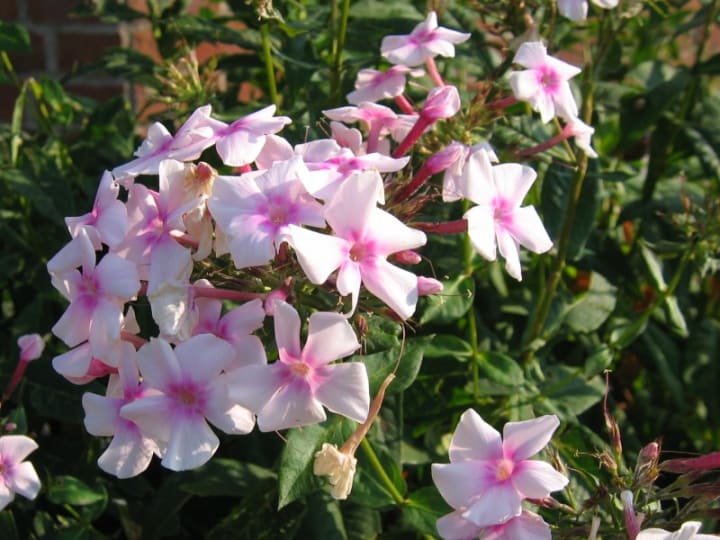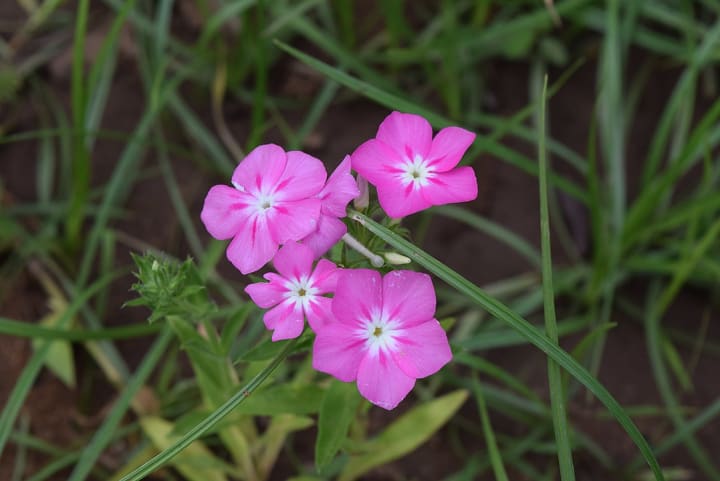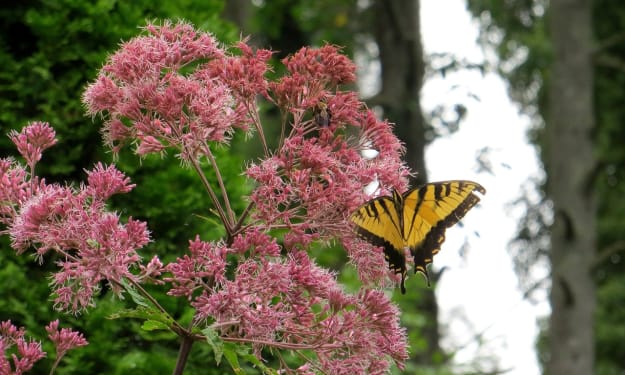Phlox Flowers 101: Beginner's Guide to Growing & Caring
Spectacular Blooms

Phlox is a fantastic addition to any garden with its vibrant blooms and delightful fragrance. Whether you're a seasoned gardener or just starting, growing Phlox can be a rewarding experience.
Phlox is a genus of flowering plants in the family Polemoniaceae. It includes many species of annuals and perennials known for their colorful and fragrant flowers. They are native to North America, and some species are found in parts of Siberia. Phlox flowers are typically clustered in dense, showy heads and come in various colors, including pink, purple, blue, and white.
In addition to their ornamental value, some species, such as Phlox paniculata, have medicinal properties and have been used in traditional herbal medicine. Phlox paniculata, commonly known as garden phlox, is a perennial species prized for its long-lasting summer flowers and often cultivated in gardens.
Different Types of Phlox Flowers
Phlox paniculata (garden phlox)

One of the most popular and widely grown Phlox varieties. It produces tall, upright stems with dense clusters of fragrant flowers. Garden phlox comes in various colors, including pink, purple, white, and bi-colored varieties. Consider the height and color preferences when choosing specific cultivars within this species.
Phlox subulata (creeping Phlox)

Creeping Phlox is a low-growing variety that forms a dense mat of foliage. It is excellent for ground covers, rock gardens, or cascading over walls. Creeping Phlox is often found in shades of pink, lavender, or white. It tends to bloom in early spring and is known for attracting pollinators like butterflies.
Phlox drummondii (annual Phlox)

Annual Phlox is a delightful variety grown as a seasonal bedding plant. It produces colorful red, pink, purple, and white blooms. They are perfect for adding vibrant splashes of color to your garden during summer.
Other Phlox species
In addition to the commonly known varieties mentioned above, there are other Phlox species worth exploring, such as Phlox maculata (meadow phlox), Phlox stolonifera (creeping Phlox), and Phlox divaricata (woodland phlox). Each species offers unique characteristics regarding growth habits, flower color, and suitability to specific growing conditions.
Consider your garden's overall design, the desired height and spread of the plants, and the color scheme you wish to achieve when selecting the suitable Phlox variety. It's also essential to consider the hardiness of the specific variety concerning your climate. Some types may be better suited to colder regions, while others thrive in warmer temperatures.
Selecting an Ideal Location
Choosing the right location is crucial for the successful growth of your Phlox plants. Consider the following factors when selecting an ideal spot:
Sunlight requirements: Phlox thrives in full sun to partial shade, depending on the specific variety. Ensure your chosen location receives at least six hours of direct sunlight daily. However, some afternoon shade can help prevent heat stress and prolong the bloom in regions with scorching summers.
Soil conditions: Phlox prefers well-drained soil that is rich in organic matter. Before planting, assess the soil's drainage by checking if it retains water or becomes overly saturated after rainfall. If the soil holds water, consider amending it with organic matter like compost or well-rotted manure to improve drainage. A slightly acidic to neutral pH level (around 6.0 to 7.0) is also ideal for Phlox.
Also Read: Guide to Growing Hellebore Flowers
Air circulation: Good air circulation around Phlox plants helps prevent fungal diseases like powdery mildew. Avoid planting them in areas prone to stagnant air, such as narrow corners or tight spaces between structures. Adequate spacing between plants can also promote air movement and reduce disease risk.
Protection from harsh elements: Consider if the chosen location provides some protection from strong winds, especially in regions prone to gusty conditions. Windy environments can damage the delicate blooms and cause the plants to become stressed. Planting Phlox near natural windbreaks, such as shrubs or fences, can offer some protection.
Garden design considerations: Consider the overall garden design and the desired visual impact when choosing the location for your Phlox. Consider placing them in the foreground or as a backdrop to taller plants for an aesthetically pleasing arrangement. Remember the color scheme and how the chosen Phlox variety will complement other flowers or foliage in your garden.
Planting Phlox
When planting Phlox, following proper techniques will help ensure your plants' successful establishment and growth. Here are some essential steps to keep in mind:
- Timing: Phlox is typically planted in early spring or fall when the weather is cool, and the soil is workable. Avoid planting during extreme heat or freezing temperatures to give the plants the best chance to establish themselves.
- Digging the hole: Dig a hole slightly larger and broader than the root ball of your plant. This extra space allows the roots to spread out and establish more quickly. The depth of the hole should be such that the plant's crown (the point where the stems meet the roots) is level with or slightly above the soil surface.
- Planting the Phlox: Gently remove the plant from its container carefully not to damage the roots. If the roots are tightly bound, you can gently tease them apart with your fingers to encourage outward growth. Place the plant in the center of the prepared hole and backfill it with soil, ensuring that the roots are covered, but the crown remains exposed. After planting, thoroughly water them to settle the soil and help the roots establish.
- Soil firming: Lightly firm the soil around the base of the plant to eliminate air pockets and provide stability. However, avoid compacting the soil too much, hindering root growth and drainage.
- Spacing: Proper spacing between plants ensures adequate air circulation and prevents overcrowding. Refer to the specific variety's recommended spacing guidelines, but as a general rule, leave about 12 to 18 inches of space between each plant.
- Staking (if needed): Some taller varieties of Phlox may require staking to provide support as they grow. If necessary, install stakes near the plants when planting to avoid damaging the roots later.
Phlox Care
Proper care is essential to keep your Phlox plants healthy, vibrant, and blooming abundantly. Here are some vital care guidelines to follow:
Watering
Phlox plants prefer slightly moist soil. Water them regularly, especially during dry spells or periods of drought. Aim to keep the soil moist but avoid overwatering, as excessive moisture can lead to root rot. Water at the base of the plants prevents wetting the foliage, which can increase the risk of fungal diseases.
Mulching
Apply a layer of organic mulch around the base of your plants to help retain soil moisture, regulate soil temperature, and suppress weed growth. Use materials like shredded bark, straw, or compost. Maintain a mulch depth of around 2 to 3 inches, ensuring the mulch doesn't directly touch the stems of the plants.
Read Also: Growing and Maintaining Hydrangea Plants
Fertilizing
Phlox plants benefit from annual balanced, slow-release fertilizer in early spring. Choose a fertilizer specifically formulated for flowering plants and follow the instructions on the package. Over-fertilizing can lead to excessive foliage growth with fewer blooms, so be cautious not to apply too much fertilizer.
Pinching back
To encourage bushier growth and more compact forms, pinch back the tips of young Phlox plants when they reach about 6 inches in height. This can be done using your fingers or pruning shears. Pinching back helps stimulate lateral branching and results in fuller, more robust plants.
Deadheading
Regularly remove spent flowers from your Phlox plants to promote continuous blooming. Deadheading prevents the plants from diverting energy into seed production and encourages them to produce more flowers. Snip off the faded blooms just above a set of healthy leaves or a side shoot.
Pest and disease management
Watch for common pests that may affect Phlox, such as aphids, spider mites, or powdery mildew. Inspect the plants regularly and take prompt action if you notice any signs of infestation or disease. Treat pest issues with organic or chemical solutions recommended for the specific pest. If powdery mildew becomes a problem, ensure good air circulation around the plants, avoid overhead watering, and consider using fungicidal sprays.
Division and Propagation
Phlox plants can benefit from division every few years to maintain their vigor and blooming performance. Divide the clumps in early spring or early fall by carefully digging up the plants and separating them into smaller sections. Replant the divisions, ensuring each section has enough roots and shoots to establish itself.
Conclusion
As you embark on planting and growing Phlox, you're stepping into a world of vibrant colors, enchanting fragrances, and the joy of nurturing life. With the knowledge and tips in this beginner's guide, you're well-equipped to cultivate thriving Phlox flowers that will transform your garden into a haven of beauty.
So, go forth passionately and enthusiastically, and let the Phlox be your companions on this horticultural adventure. As you nurture their growth, they will reward you with their vibrant presence, reminding you of the wonders of nature and the joy of tending to something truly magical. Happy gardening!
👉 Do you have any additional insights or questions? We highly value your feedback. Please share your thoughts by leaving a comment below.
Join today to share and publish your content on Vocal Media and earn money.
About the Creator
Amir Hossain
I blog on everything and anything— hoping my blogs will make your days a bit happier!






Comments
There are no comments for this story
Be the first to respond and start the conversation.